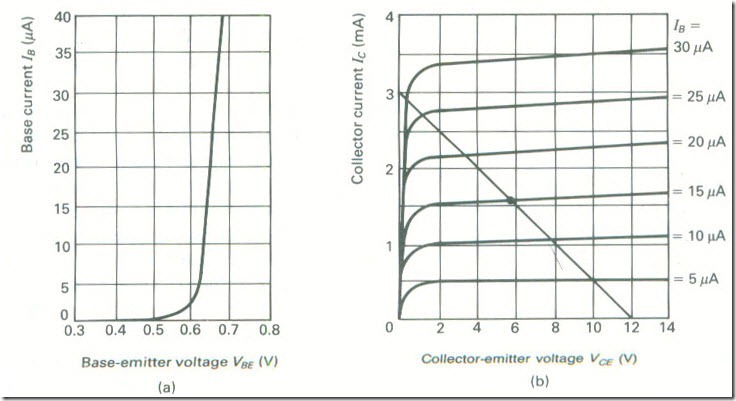Design of a single-state Audio-frequency Amplifer
In the design of a single-stage audio-frequency amplifier a number of factors must be taken into account. These include the choice of operating point and the required voltage gain. Other factors such as the required bandwidth and the noise performance are also of importance but are beyond the scope of this book. There are several different approaches to the design of an amplifier available and here just one of them is given.
Suppose that an amplifier stage is to deliver the maximum possible output voltage so that the d.c. collector-emitter voltage VCE will be set at one-half of the supply voltage VCC. Assuming for the moment, that the rest of the supply voltage is dropped across the collector
resistor R3, then Vcc/2 = lcR3). This gives the maximum possible output voltage. The voltage gain Av = gmR3 = 40lc X Vcc/2lc = 20 Vcc . This approximate relationship will allow a choice to be made of the collector supply voltage to allow a wanted gain to be obtained, or alternatively, if the supply voltage is already fixed by other considerations, it will establish the maximum possible voltage gain.
A suitable d.c. load line can be drawn on the output characteristics of the transistor and the operating point located at Vcc/2 volts. This allows the collector current to be detennined. Alternatively, a collector current may be arbitrarily selected, which will very often be the value quoted in the data sheet for the typical value of hFE.
The collector resistor can then be determined from R3 = Vcc/2Ic. The potential divider bias circuit must establish the required operating point and also provide adequate d.c. stability. If hFER4 >> R1R2/(R1 + R2) the collector current will be very nearly equal to (VB – VBE)IR4, i.e. it will be independent of hFE. The collector current is then still subject to variations due to changes in VSE but this factor may be minimized by making VB several times larger than VBE Since VE = VE + VBE this means that the voltage across R4 should not be less than about 1V. A good rule is to make VE equal to Vcc/10 with a minimum value of I V.
For the circuit to operate correctly the base voltage VB should remain more or less constant at VB = VccR2/(R1 + R2) as the collector current and thus VE = IcR4 varies. To achieve this the current flowing through the lower bias resistor R2 must be several times larger, by a factor n, than the base current IB = Ic/hFE . The larger the factor n the better will be the d.c. stability of the circuit but the lower will be the values of the resistors R1 and R2. Since R1 and R2 are effectively in parallel, both with the signal path and with one another, their values must not be too small. This means that the choice of n must be a compromise between the a.c. and d.c. performances of the circuit. A suitable choice for n is 10.
Then, R2 = VB/nIB and R1 = (Vcc – VB)/(n+ I)IB. Calculation of suitable values for the coupling and decoupling capacitors is more difficult and values such as those quoted in Table 1 should be used.
Example 14
Design an audio-frequency single-stage amplifier to have a voltage gain of about 240 using the transistor whose characteristics are given in Fig. 36. The maximum possible output voltage is required.
Solution
Voltage gain = 240 = 20Vcc , or Vcc = 240/20 = 12 V. The operating point is then set at VCE = 6 V, IB = 15 /πA . The d.c. load line has been drawn through these two points. The d.c. collector current is then 1.5 mA and hFE = (1.5 x 10-3)/(15 x 10-6) = 100.
The slope of the load line is (12 – 6)/(1.5 – 0) x 10-3 = 4000 Ω. The emitter voltage VE = Vcc/l0 = 12/10 = 1.2 V. Hence, R4 = 1.2/(1.5 X
10-3) = 800 Ω. Choosing the nearest preferred values for R3 and R4; R3 = 3900 Ω and OO R4 = 820 Ω. Now the voltage drop across (R3 + R4) is 1.5 X 10-3 X (3900 + 820) = 7 V which leaves VCE. as 5 V.
The base current IB = Ic/hFE = 15 πA. Therefore, choose the current in R2 to be 150 μA. From Fig. 36a , when IB = 15 μA, VBE = 0.65 V, giving Vs = 1.2 + 0.65 = 1.85 V. Then,
R2 = 1.85/(10 x 15 x 10-6) = 12.3 kΩ
R1 = (12 – 1.85)/(11 x 15 x 10-6) = 61.5 kΩ
Choosing the nearest preferred values, R2 = 12 kΩ and R1 = 62 kΩ.
The midband voltage gain will be gmR3 = 38 x 1.5 x 10-3 x 3900 = 222. To increase the gain nearer to the wanted target of 240 the next higher preferred value for R3 could be used. i.e. R3 = 4300 Ω . Then Av = 245 but the maximum output voltage will be reduced .

